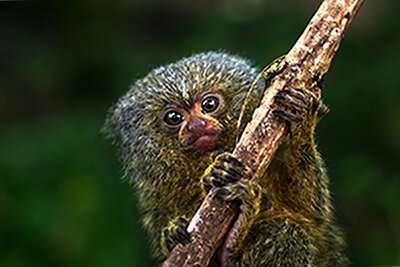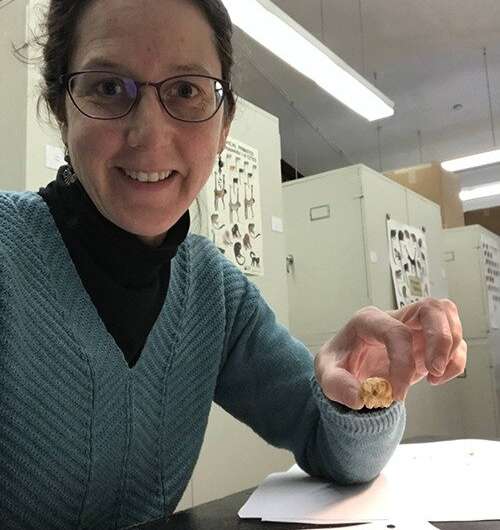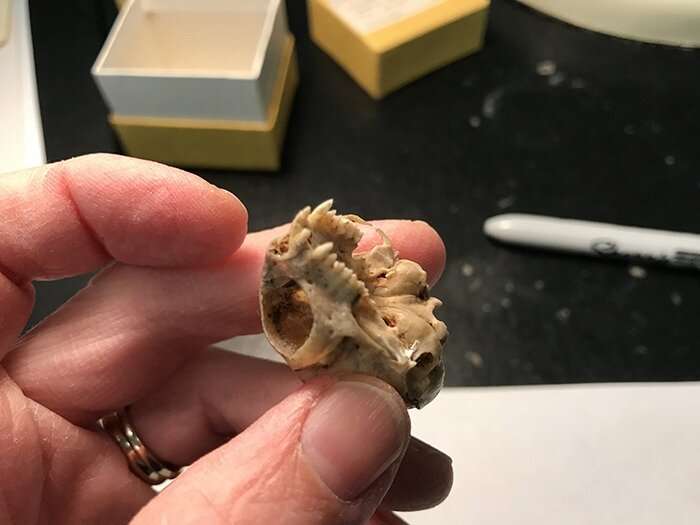A “northwestern” pygmy marmoset from Ecuador. Credit: P. Yépez
A new study confirms that there are two separate species of threatened pygmy marmosets but finds they can't be distinguished by fur coloring, as was previously thought. The study also broadens the distribution range for both species to include Ecuador and Peru.
Found in the Amazon region of South America, pygmy marmosets are the smallest monkeys in the world. Adults weigh about four ounces, with the length of the head and the body together stretching just six inches.
Two species had been proposed to exist, based on fur coloring and more recently on genetic analyses. However, fur color seemed highly variable and not exclusive to a particular region.
"Our study showed the two species are not distinguishable by their fur color, but they are distinguishable by differences in their mitochondrial DNA and skull structure," says NIU biological anthropologist Leila Porter, who led the research, published in the American Journal of Physical Anthropology.
Three other primatologists collaborated on the work: Stella de la Torre from the University of San Francisco de Quito, Ecuador; Liliana Cortés-Ortiz from the University of Michigan-Ann Arbor; and Pedro Pérez-Peña from the Peruvian Amazon Research Institute. The study was funded in part by the Chicago Board of Trade Fund for Endangered Species.
Leila Porter measuring the skull of a pygmy marmoset in the collection of the American Museum of Natural History. Credit: Leila Porter
The new research builds on past findings. In 2018, a group of scientists using genetic analyses confirmed two separate species of pygmy marmoset living in Brazil. Porter's research team extends the range of both species to Ecuador and Peru. In Ecuador, the species appear to be separated by the Napo River, a tributary to the Amazon River.
Pygmy marmosets live in family groups made up of an adult male and female and their offspring of various ages. The monkeys are cooperative breeders; the female usually gives birth to twins who are cared for mainly by their father and older siblings. They are also unusual in that they regularly gouge trees to feed on the gum that the trees produce to seal their wounds.
In 2017, Porter, an NIU Presidential Engagement Professor, examined pygmy marmosets in the collections of the Field Museum in Chicago and the American Museum of Natural History in New York. The specimens had been collected in Ecuador and Peru in the 1920s. She took cranial measurements of the specimens to determine if there were identifiable differences in the sizes and shapes of skulls from across the region. She also photographed all the pelts of the monkeys in the collection and took small pieces of material from each specimen for her colleague Cortes-Ortiz.
Cortes-Ortiz was able to extract mitochondrial DNA from the museum material and from new fecal samples collected by de la Torre and Perez-Pena at field sites. Cortes-Ortiz was then able to compare genetic similarities among the specimens.
The testing revealed two distinct genetic groups with slightly different skull shapes. The results, based on cranial and molecular differences, are enough to officially recognize two distinct species, but not based on fur coloration.
The skull and upper jaw of a pygmy marmoset from the Field Museum’s collection, Chicago. Photo Credit Leila Porter
In the past, the monkeys were commonly known as "eastern" and "western" pygmy marmosets. Porter's research team is recommending those be reclassified as "northwestern" and "southern" to accurately reflect where the species live.
The research team is working with colleagues in Brazil and Europe to officially name the second species. According to Porter, the results open the door for additional research on the two species.
"Comparisons of their skull structure suggest they could have slightly different adaptations for foraging," Porter says. "For example, they might gouge on different kinds of tree species with different kinds of bark. In addition, there could be other behavioral and ecological differences between the species that have not been documented."
The International Union for Conservation of Nature's Red List considers pygmy marmosets to be vulnerable to extinction due to habitat loss and the pet trade.
"It is important to further study each species to better develop management plans for their protection," Porter says.
More information: Leila M. Porter et al, Taxonomic diversity of Cebuella in the western Amazon: Molecular, morphological and pelage diversity of museum and free‐ranging specimens, American Journal of Physical Anthropology (2021). DOI: 10.1002/ajpa.24266
Journal information: American Journal of Physical Anthropology
Provided by Northern Illinois University
























